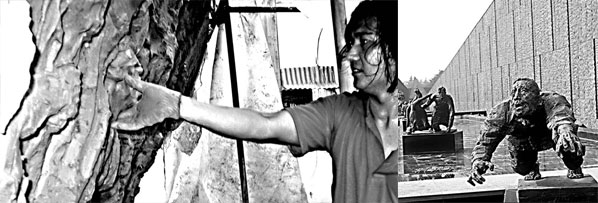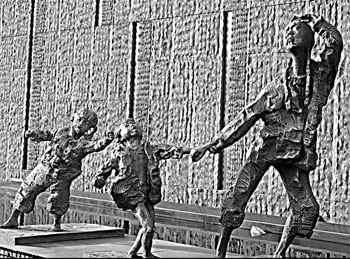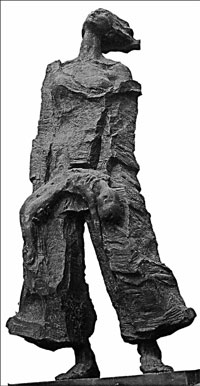Wu Weishan etches Nanjing Massacre memory in bronze
|
(Left): Professor Wu making sculptures for the Nanjing Massacre Memorial Hall (Right): Seeking Survival — a part of Fleeing from Calamity |
On the same day expansion of the Nanjing Massacre Memorial Hall was completed on December 13, 2007, bronze sculptures by renowned Chinese artist Wu Weishan were also unveiled, their figures invoking the horror and heartbreak of the massacre that remain today, even after seventy years.
December 13 is a date that Chinese people cannot forget. It was on that winter day in 1937 that the Japanese army captured Nanjing, and in the months that followed, invading troops slaughtered more than 300,000 Chinese soldiers and civilians, transforming the city into a hell on earth.
Wu's sculptural works outside the memorial hall are an impressive introduction to the memorial, the first images visitors see of the memories that live on.
The largest of all is a 12-m-high sculpture titled Destroyed Family that depicts a grieving mother holding her dead son and crying to the heavens. Her body weathered by time and covered in ragged clothes, the work is a symbol of the millions of suffering mothers in the nation.
|
Orphans — a part of Fleeing from Calamity |
The shape of the sculpture also resembles the Chinese character ren - human being - symbolizing that the misery of the city and the nation is actually a tragedy for all humanity.
The Fleeing from Calamity group of 10 sculptures has 21 figures, including women, children and old people, intellectuals, ordinary city residents and even a Buddhist monk.
Among the sculptures, the most disturbing is the Last Drop of Milk. It depicts the true story told by Chang Zhiping, a massacre survivor who witnessed his baby brother taking the last milk from the breast of his dying mother. The most moving might be the sculpture of a Buddhist monk, his eyes closed in prayer for the souls of those killed .
Another work, Screams of the Souls of the Dead, is made of two geometric forms, one with a dying man reaching his hand to the sky and shouting in anguish. A gap between the two forms is the gateway to the museum, symbolizing both a passage to death and life. When walking through the gate, visitors cannot help but to feel a hatred of war and a longing for peace.
Peace Park outside the museum displays the Wall of Victory, a sculptural relief 140 m long and 8 m high. A large V, representing victory, is sculpted into the surface along with a Chinese soldier blowing the bugle of victory and stepping on a steel helmet and bayonet from the invading army.
Recording history
In an interview with the media, sculptor Wu Weishan recalled many deep feelings were part of his artistic creation.
He remembered that after he was given the commission for the works, he paid a visit on December 15, 2005 to the museum, which is built on one of the sites of the massacre.
"It was wintertime, when the cold wind was blowing, giving me a feeling that it was full of the furious screams of dead souls. The feeling was intensified by many newly unearthed skeletons and bones that were exhibited in the museum," Wu said.
"At the museum, I also saw some Japanese people presenting bouquets to the dead, with an attitude of repentance," Wu added. "I am so glad to see the Japanese people's willingness to admit the tragedy caused by their nation in the past."
|
Destroyed Family |
However, Wu remembered his visit to Japan in April 2005, when some in Japan asked him why the Chinese people still talk so much about something that happened more than 60 years before.
He answered that "having a better understanding of the true history is the start of preventing such a tragedy from happening again".
The artist said he feels a responsibility to tell the truth to the whole world, especially to the Japanese people, adding that he hopes his artistic creations convey the values of peace and dignity that the Chinese nation cherishes.
In fact Wu's sculptures all depict Chinese people - there is not a single image of the Japanese invaders.
"I like to focus my sympathy on the victims because the basis of my works is a strong longing for peace and dignity," Wu explained.
"And what I'd like to impart to Japanese visitors is that we should remember history, but not hatred," Wu said.
Profile of the artist
Professor Wu Weishan was born in January 1962 in Dongtai, Jiangsu province.
He is now a delegate of the National Committee of the Chinese People's Political Consultative Conference, honorary professor of Inje University in South Korea, a member of Royal British Society of Sculptors, a member of Chinese Artists Association, president of the Sculpture Institute of the Chinese Academy of Arts and president of the Art Academy of Nanjing University.
Wu began to engage himself in figure sculpture in 1990 and has created over 500 sculptures of famous Chinese historical figures. He uses a freehand brushwork style in his sculptures, combining elements of calligraphy, Chinese painting and sculpture.
His works have been exhibited in more than 10 countries, as well as more than 20 provinces and municipalities in China.
In 1996, Wu made a sculpture for Queen Beatrix of the Netherlands.
In 1999, a permanent Wu Weishan Figure Sculpture Gallery opened at Nanjing Museum.
In 2001, the Wu Weishan Sculpture Studio was launched in Macao.
In 2007, the Wu Weishan Sculpture Garden was unveiled at Inje University, South Korea.
In 2007, 31 of his sculptures were placed in Yuantouzhu Park in Wuxi, Jiangsu province.
In 2007, Wu Weishan made a sculpture for Philippine President Gloria Macapagal-Arroyo.
|
(Left): Last Drop of Milk — a part of Fleeing from Calamity (Right): Screams of the Souls of the Dead |
(China Daily 03/13/2008 page16)


















